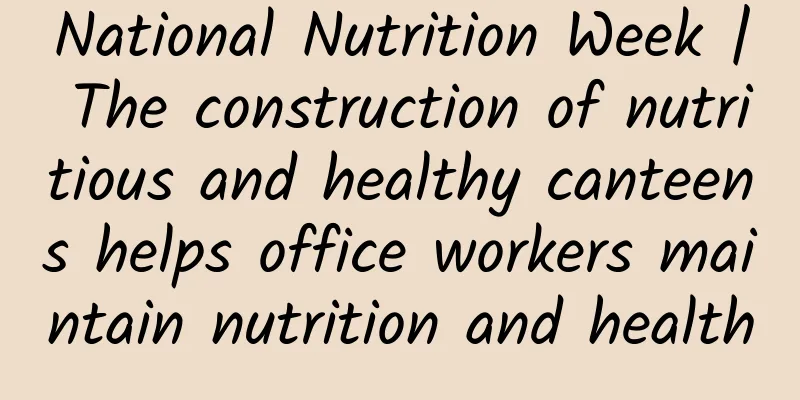National Nutrition Week | The construction of nutritious and healthy canteens helps office workers maintain nutrition and health

|
On December 4, 2020, the National Nutrition and Health Steering Committee issued the "Guidelines for the Construction of Nutritional and Healthy Canteens" (hereinafter referred to as the "Guidelines"). The formulation of the "Guidelines" is based on meeting the nutritional and health needs of employees and promoting the healthy development of unit canteens. It aims to standardize and guide the construction of nutritional and healthy canteens. It guides unit canteens to build in various aspects such as organizational management, personnel training and assessment, nutritional and health education, meal preparation and cooking, and meal service, becoming a powerful tool for units to carry out nutritional and health management and for employees to improve their self-nutrition management capabilities. Applicable to: The Guidelines are mainly applicable to food operators whose main business is company canteens (staff canteens), and canteens in primary and secondary schools and colleges can refer to them for implementation. The Guidelines mainly focus on reasonable diet and "three reductions", and stipulate the requirements that should be met in building nutritious and healthy canteens. For example, in building a nutritious and healthy canteen, the basic requirements that should be met first include: no food safety accidents for three consecutive years, no administrative penalties related to food safety for two consecutive years; equipped with qualified full-time (or part-time) nutrition counselors; setting up a "nutrition and health corner" and placing equipment and tools for measuring height, weight, blood pressure, etc. and maintaining them regularly, and posting self-testing and self-evaluation methods; nutritional labeling of the food provided; when the canteen provides homemade drinks or desserts, the added sugar content should be indicated; establish a system to prevent and resist food waste, and take measures to implement it, etc. Core Requirements: The "Guidelines" suggest that nutritious and healthy canteens should regularly publicize the weekly salt, oil, and sugar usage and the average daily or meal intake per person, and achieve corresponding targets. In terms of meal planning and cooking, each meal should include at least three types of food, including cereals, potatoes, beans, vegetables and fruits, aquatic products, poultry, livestock, eggs, milk and soybeans; in food cooking and processing, it is encouraged to give priority to food cooking methods that reduce nutrient loss and maintain natural flavor, and use less frying, pan-frying, smoking, baking and other cooking methods; low-salt, low-oil and low-sugar dishes should be provided, and the supply of dishes with high salt, oil and sugar content should be reduced; salt and sugar should not be placed in canteen dining areas. In addition, canteens that provide nutritional health should formulate reasonable dietary nutrition meal plans. For canteens that provide set meals or portion meals, the menus should not be repeated as much as possible within a week. At the same time, canteens that provide free meals are encouraged to provide standardized meal packages based on seasonal climate and weather, the labor intensity of the unit's employees, and the age and gender structure, so as to meet the energy and main nutrient needs of employees in one meal. Canteens are encouraged to provide meals based on the health status of diners and provide special nutritional meals to people with obesity or nutrition-related diseases. Meal service requirements: The Guidelines require canteens to adopt a separate dining system. Among them, canteens that provide free food should be equipped with public chopsticks, spoons or tongs for each dish; canteens that provide table meals should be equipped with public chopsticks, spoons and other meal-separating tools, and guide diners to use them; they should actively sell small or half-portion dishes, economical meal packages, etc. In addition, free boiled water or direct drinking water should be provided; hand washing and disinfection facilities or supplies should be equipped. Keep a certain distance between seats to avoid high-density gatherings for dining. In order to achieve the above-mentioned requirements of reasonable diet, "three reductions" and separate meals, organizational management is an indispensable guarantee for building a nutritious and healthy canteen. The canteen should set up a nutrition and health management committee composed of unit leaders, logistics, trade unions and canteen management personnel, and provide personnel, funds and other support for the construction of a nutritious and healthy canteen; establish and improve corresponding systems, including raw material procurement, nutrition and health management, salt, oil and sugar procurement, ledgers, etc. Environmental construction: Nutrition and health canteens should use various forms to publicize policies and popular science knowledge such as reasonable diet, "three reductions", prevention and treatment of nutrition-related chronic diseases, prevention and control of infectious diseases, and saving food, so as to create a nutritious and healthy dining atmosphere; organize and hold publicity activities related to dietary nutrition. It is encouraged to actively promote nutrition and health knowledge and solicit opinions and suggestions from diners. At the same time, canteens are encouraged to use intelligent systems to guide meal preparation and dining. The release of the Guidelines has attracted wide attention from the catering and health industries. Many regions across the country have carried out pilot demonstrations of the construction of nutritious and healthy canteens, and have gradually promoted the construction of nutritious and healthy canteens and restaurants in their jurisdictions. These efforts will lay a solid foundation for further promoting reasonable dietary actions, improving the level of nutritional and health services, and promoting the transformation and upgrading of the catering industry! The National Nutrition Week takes "reasonable diet benefits thousands of families" as its core concept, and promotes the formation and consolidation of healthy eating habits for all people. We believe that by actively creating a healthy food environment and social atmosphere through the three levels of government, society, individuals and families, we will build a situation where reasonable diet is jointly built and shared by all people, and effectively promote the construction of a healthy China! Author: Ding Caicui | Associate Researcher, Institute of Nutrition and Health, Chinese Center for Disease Control and Prevention Reviewer: Ding Gangqiang | Director of the Institute of Nutrition and Health, Chinese Center for Disease Control and Prevention |
Recommend
What are the effects of miscarriage on the body?
Abortion is a relatively harmful thing to women&#...
Can I eat egg pancakes during menstruation?
Can you eat omelet during menstruation? To know t...
Don’t let disinfection become “poisoning”, this is how to do home disinfection safely!
Recently, with the adjustment of national epidemi...
Does ovarian cyst cause stomach pain?
Ovarian cysts are a common gynecological disease ...
What are the treatments for uterine polyps?
Many women will find that they have uterine polyp...
What is the normal value of mature follicles? What are the characteristics?
Pregnancy is the most important thing in a woman&...
What causes women's urinary incontinence?
As the saying goes, people have three urgent need...
When is the flowering period of osmanthus? What is the growth environment of osmanthus like?
Osmanthus is a famous flower that is deeply loved...
How many times a woman ovulates in a month and what to pay attention to
We all know that the incidence of diseases is inc...
Insomniacs can't fall asleep, so they keep taking sleeping pills? The love-hate relationship between insomniacs and sleeping pills
Author: Jiang Molin Beijing Hospital of Tradition...
Self-examination of female genital ulcer symptoms
When many women find out they have gynecological ...
Lived in vain! Today you will understand why women are made of water
As the saying goes: women are made of water, and ...
The virus strain "Lambda" has appeared! It has spread to about 30 countries and regions
According to CNN, as the COVID-19 pandemic spread...
Red spots on the vagina
When women reach adulthood, it is difficult to de...
What is the cause of wrist pain when playing tennis? What to do if your wrist hurts when playing tennis
The power of a tennis racket and a ball is much g...









